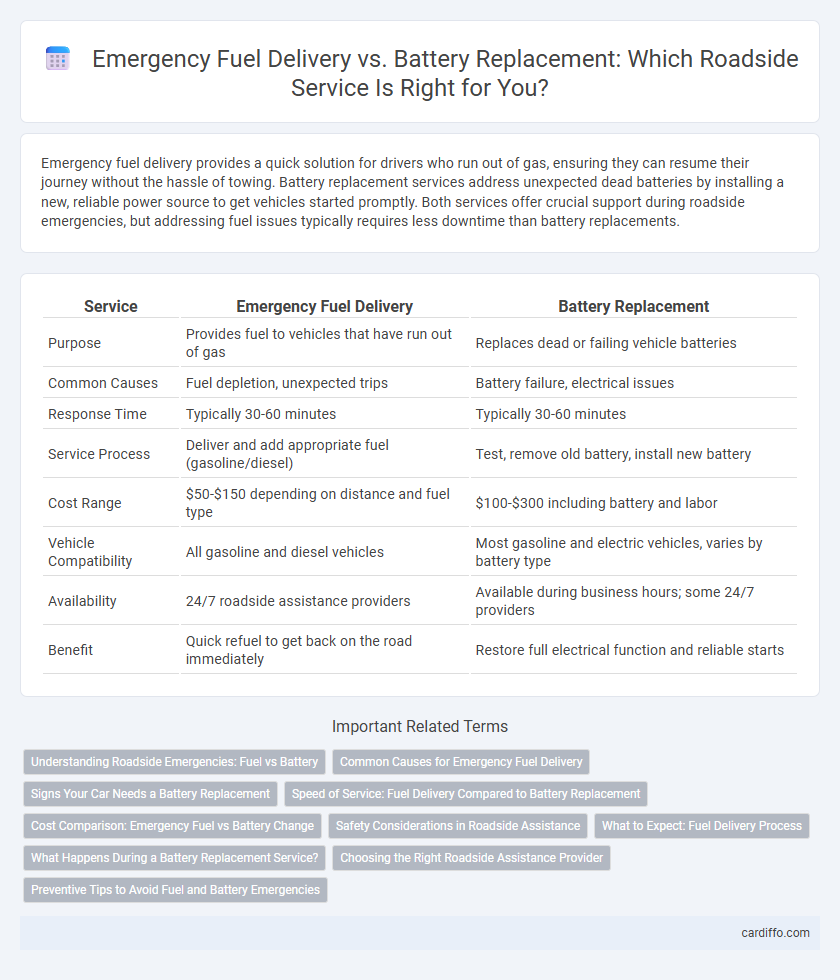Emergency fuel delivery provides a quick solution for drivers who run out of gas, ensuring they can resume their journey without the hassle of towing. Battery replacement services address unexpected dead batteries by installing a new, reliable power source to get vehicles started promptly. Both services offer crucial support during roadside emergencies, but addressing fuel issues typically requires less downtime than battery replacements.
Table of Comparison
| Service | Emergency Fuel Delivery | Battery Replacement |
|---|---|---|
| Purpose | Provides fuel to vehicles that have run out of gas | Replaces dead or failing vehicle batteries |
| Common Causes | Fuel depletion, unexpected trips | Battery failure, electrical issues |
| Response Time | Typically 30-60 minutes | Typically 30-60 minutes |
| Service Process | Deliver and add appropriate fuel (gasoline/diesel) | Test, remove old battery, install new battery |
| Cost Range | $50-$150 depending on distance and fuel type | $100-$300 including battery and labor |
| Vehicle Compatibility | All gasoline and diesel vehicles | Most gasoline and electric vehicles, varies by battery type |
| Availability | 24/7 roadside assistance providers | Available during business hours; some 24/7 providers |
| Benefit | Quick refuel to get back on the road immediately | Restore full electrical function and reliable starts |
Understanding Roadside Emergencies: Fuel vs Battery
Emergency fuel delivery offers a timely solution for drivers stranded without gasoline, restoring mobility by refueling vehicles on-site. Battery replacement services address power failures caused by dead or faulty batteries, ensuring vehicles start reliably after roadside assistance. Both interventions target common roadside emergencies but differ in underlying causes and required response times, emphasizing the need for specialized roadside support tailored to either fuel depletion or electrical system failures.
Common Causes for Emergency Fuel Delivery
Emergency fuel delivery is commonly required due to unexpected fuel depletion caused by inaccurate fuel gauge readings, driver oversight, or longer-than-anticipated travel distances. Running out of fuel is a prevalent roadside issue leading to vehicle immobilization, necessitating rapid fuel delivery services to avoid prolonged delays. In contrast, battery replacement typically results from electrical failures or dead batteries, which differ fundamentally from fuel-related emergencies.
Signs Your Car Needs a Battery Replacement
Signs your car needs a battery replacement include slow engine crank, dim headlights, and the check engine light illuminating on the dashboard. Frequent jump-starts, swollen battery casing, or corrosion around terminals also indicate battery failure. Ignoring these symptoms can lead to sudden breakdowns, making emergency fuel delivery ineffective compared to timely battery replacement.
Speed of Service: Fuel Delivery Compared to Battery Replacement
Emergency fuel delivery typically offers faster service than battery replacement, often restoring vehicle operation within 30 minutes or less. Battery replacement can take 45 minutes to over an hour, due to diagnostics, battery retrieval, and installation. Swift fuel delivery reduces roadside downtime significantly, enhancing convenience in urgent situations.
Cost Comparison: Emergency Fuel vs Battery Change
Emergency fuel delivery typically costs between $50 and $150, making it a cost-effective solution for drivers who run out of gas. Battery replacement expenses range from $100 to $300 depending on the vehicle make and battery type, often making emergency fuel delivery a more affordable option in urgent roadside scenarios. Considering price alone, emergency fuel delivery generally provides immediate assistance at a lower cost compared to the more expensive and time-consuming battery change.
Safety Considerations in Roadside Assistance
Emergency fuel delivery reduces the risk of vehicle immobilization by quickly supplying the needed fuel, minimizing exposure to traffic hazards during roadside stops. Battery replacement requires handling heavy batteries and electrical components, posing potential safety risks such as acid spills or electric shocks, which must be managed with proper protective equipment and trained technicians. Prioritizing safety protocols during both services ensures the protection of drivers and roadside assistance personnel in high-traffic environments.
What to Expect: Fuel Delivery Process
Emergency fuel delivery involves a technician bringing the exact type of fuel required to your stranded vehicle, usually within 30 to 60 minutes depending on location and traffic. The process includes verifying fuel type, safely transferring fuel directly into the tank, and inspecting for leaks or fuel system issues. Unlike battery replacement, this service quickly resolves fuel-related breakdowns without extensive vehicle diagnostics or prolonged downtime.
What Happens During a Battery Replacement Service?
During a battery replacement service, a trained technician first performs a thorough diagnostic test to confirm the battery's failure and assess the vehicle's electrical system. The technician then removes the old battery, cleans the terminals, and installs a new, fully charged battery compatible with the vehicle's specifications. Finally, the technician tests the new battery and restarts the vehicle, ensuring all electrical components function properly before completing the service.
Choosing the Right Roadside Assistance Provider
Emergency fuel delivery services offer quick refueling to stranded drivers, especially in areas with limited gas station access, while battery replacement provides on-the-spot power restoration for dead batteries. Selecting the right roadside assistance provider depends on their response time, geographic coverage, and availability of specialized services like fuel delivery and battery jump-start or replacement. Prioritize providers with certified technicians and transparent pricing to ensure reliable and efficient roadside support during emergencies.
Preventive Tips to Avoid Fuel and Battery Emergencies
Regular vehicle maintenance, including timely fuel checks and battery inspections, significantly reduces the risk of roadside emergencies. Keeping an emergency fuel container and portable battery charger in your car ensures preparedness for unexpected situations. Monitoring dashboard warning lights and avoiding extreme temperature exposures further prevent fuel depletion and battery failure during travel.
Emergency Fuel Delivery vs Battery Replacement Infographic

 cardiffo.com
cardiffo.com